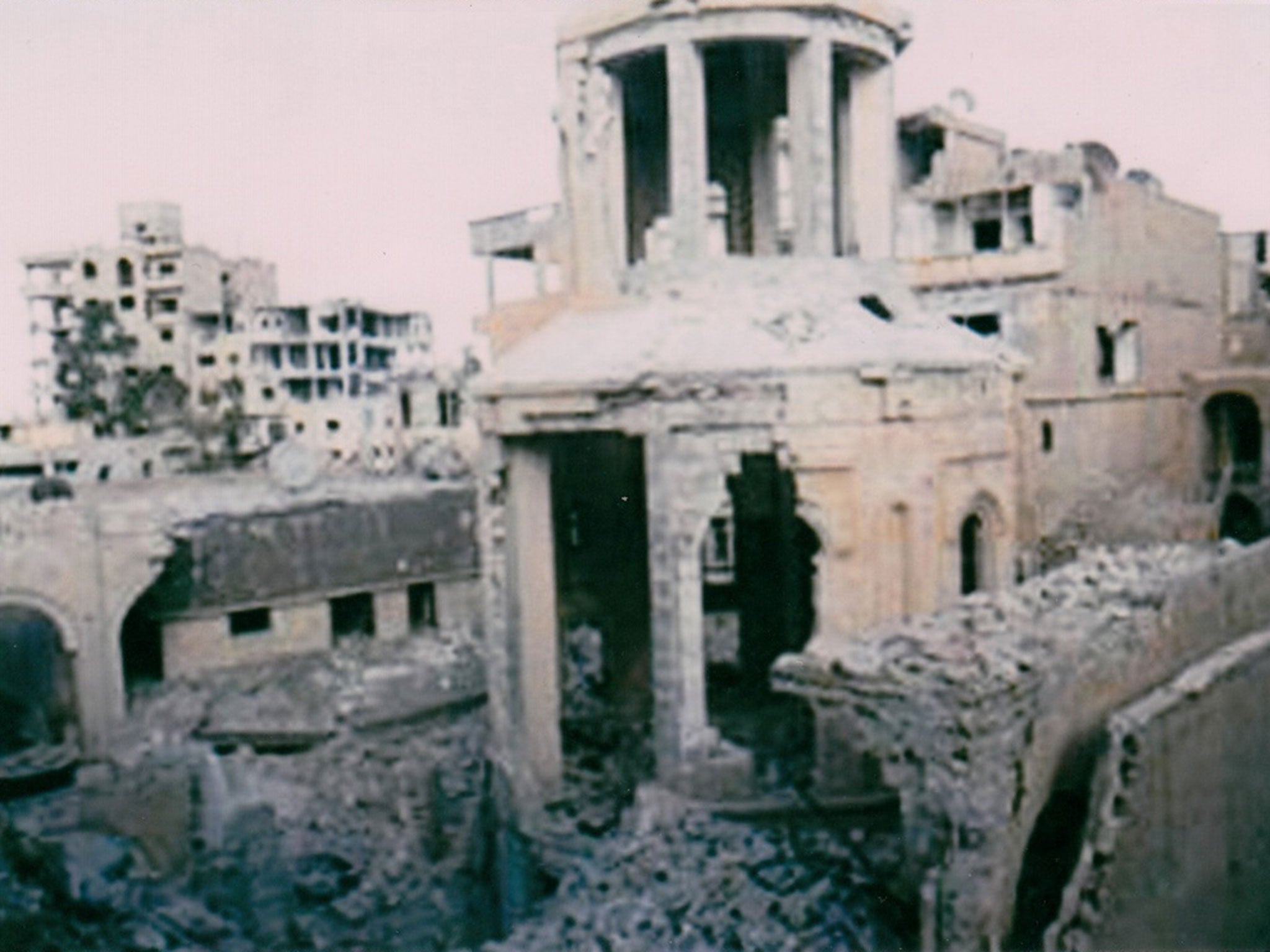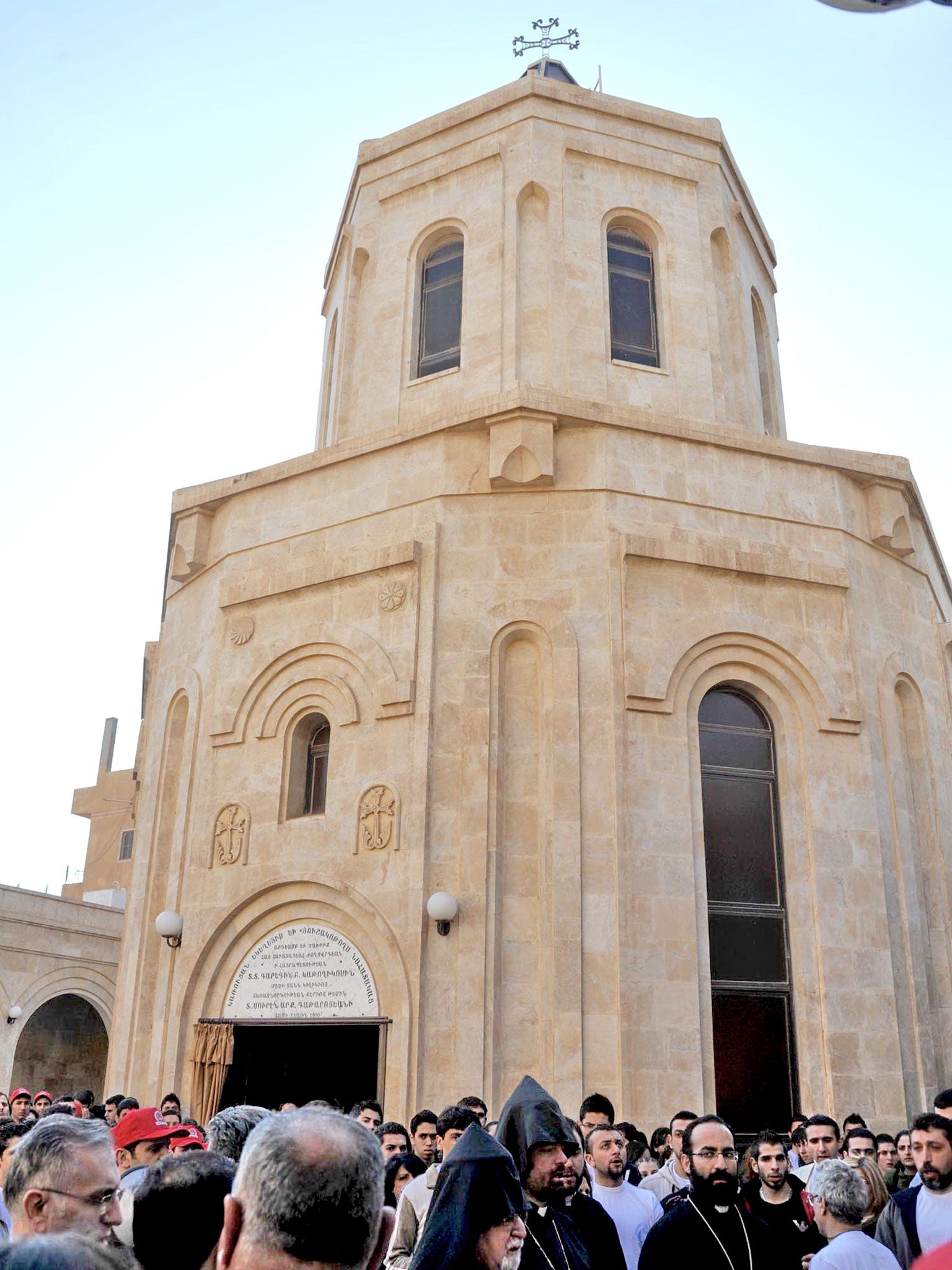Jabhat al-Nusra blows up Armenian church in Deir el-Zour: A savage blow that echoes through Armenian history
Islamists’ destruction of a shrine to the victims of genocide marks the latest chapter in a tragic national history. Robert Fisk reports from Qamishli, north-eastern Syria

In the most savage act of vandalism against Syria’s Christians, Islamists have blown up the great Armenian church in Deir el-Zour, which is dedicated to the one and a half million Armenians slaughtered by the Turks during the 1915 genocide. All of the church archives, dating back to 1841 and containing thousands of documents on the Armenian Holocaust, were burned to ashes, while the bones of hundreds of genocide victims, packed into the church’s crypt in memory of the mass killings 99 years ago, were thrown into the street beside the ruins.
This act of sacrilege will cause huge pain among the Armenians scattered across the world – as well as in the rump state of Armenia which emerged after the 1914-1918 war, not least because many hundreds of thousands of victims died in death camps around the very same city of Deir el-Zour. Jabhat al-Nusra rebels appear to have been the culprits this time, but since many Syrians believe that the group has received arms from Turkey, the destruction will be regarded by many Armenians as a further stage in their historical annihilation by the descendants of those who perpetrated the genocide 99 years ago.
Turkey, of course, miserably claims there was no genocide – the equivalent of modern day Germany denying the Jewish Holocaust – but hundreds of historians, including one prominent Turkish academic, have proved beyond any doubt that the Armenians were deliberately massacred on the orders of the Ottoman Turkish government across all of modern-day Turkey and inside the desert of what is now northern Syria – the very region where Isis and its kindred ideological armed groups now hold. Even Israelis refer to the Armenian genocide with the same Hebrew word they use for their own destruction by Nazi Germany: “Shoah”, which means “Holocaust”.
The Armenian priest responsible for the Deir el-Zour district, Monsignor Antranik Ayvazian, revealed to me that before the explosions tore the church apart towards the end of September, he received a message from the Islamists promising to spare the church archives if he acknowledged them as the legislative authority in that part of Syria. “I refused,” he said. “And after I refused, they destroyed all our papers and endowments. The only genocide victims’ bones left were further north in the Murgada sanctuary and I buried them before I left. They destroyed the church there, but now if I could go back, I don’t even know if I could find where I put the bones.”

Msr Ayvazian later received a photograph taken in secret and smuggled to him from the Isis-controlled area, showing clearly that only part of the central tower of the Deir el-Zour church, built in 1846 and renovated 43 years later, remains. Every Armenian who has returned to the killing fields of the genocide has prayed at the church. Across these same lands, broken skulls and bones from 1915 still lie in the sand. When I investigated the death marches in this same region 22 years ago with a French photographer, we uncovered dozens of skeletons in the crevasse of a hill at a point where so many Armenian dead were thrown into the waters of the Khabur that the river changed its course forever. I gave some of the skulls and bones we found to an Armenian friend who placed them in the crypt of the Deir el-Zour church – the very same building which now lies in ruins.
“During the Armenian genocide, the Turks entered the church and killed its priest, Father Petrus Terzibashian, in front of the congregation,” Msr Ayvazian said. “Then they threw his body into the Euphrates. This time when the Islamists came, our priest there fled for his life.” Msr Ayvazian suffered his own personal loss in the Syrian war when Islamist fighters broke into the Mediterranean town of Qassab on 22 April this year. “They burned all my books and documents, many of them very old, and left my library with nothing but 60cm of ash on the floor.” Msr Ayvazian showed me a photograph of the Qassab church altar, upon which one of the Islamists had written in Arabic: “Thanks be to God for al-Qaeda, the Nusra Front and Bilal al-Sham” (another Islamist group). The town was retaken by Syrian government troops on 22 June.
Msr Ayvazian recounted his own extraordinary story of how he tried to prevent foreign Islamist fighters from taking over or destroying an Armenian-built hospital – how he drove to meet the Islamist gunmen and agreed to recover the corpses of some of their comrades killed in battle in return for a promise not to damage the hospital. “As I approached the hospital, a Syrian jet flew over me and dropped a bomb 40 metres from the building. I know the officer who sent the aircraft. He said it was his way of trying to warn the rebels not to harm me. They came out of the hospital like rats – but they did not harm me.”
I spoke later to the local Syrian military air force dispatcher and he confirmed that he had indeed sent a MiG fighter-bomber to attack waste ground near the building. Msr Ayvazian subsequently went to the old battlefield with Syrian government permission and recovered several bodies, all in a state of advanced decay and one with a leg eaten off by dogs. But he bravely set off with trucks carrying the dead and handed the remains to the Islamists. “They kept their word and later withdrew all their foreign fighters from the province of Hassake. I later received a letter from one of their emirs, very polite, telling me – and here the priest produced a copy of the note – that: “We vow to keep your property and your cherished possessions, which we also hold dear to us.” Msr Ayvazian looked scornfully at the letter. “Look, here at the start,” he said, “they have even made a mistake in their first quotation from the Koran! And then look what happened at Deir el-Zour. It was all for nothing.”
Each year, thousands of Armenians have gathered at their church in Deir el-Zour on 25 April – the date they commemorate the start of the genocide, when Armenian lawyers, teachers and doctors were arrested and later executed by the Turks outside Istanbul – to remember their million and a half dead. The 100th anniversary of the mass slaughter would have been a major event in Deir ez-Zour’s history. And although Syrian soldiers are still holding out in part of the town today, and Syrian authorities have promised to rebuild Armenian churches when their lands are retaken from the Islamists, there is little hope that any Armenians will be able to visit the ruins of their church in five months’ time. As for the Turks, they will do their best to stifle interest in the Armenian Holocaust by holding their own commemorations next year – to mark their victory over Allied troops at the 1915 battle for Gallipoli.
Join our commenting forum
Join thought-provoking conversations, follow other Independent readers and see their replies
Comments